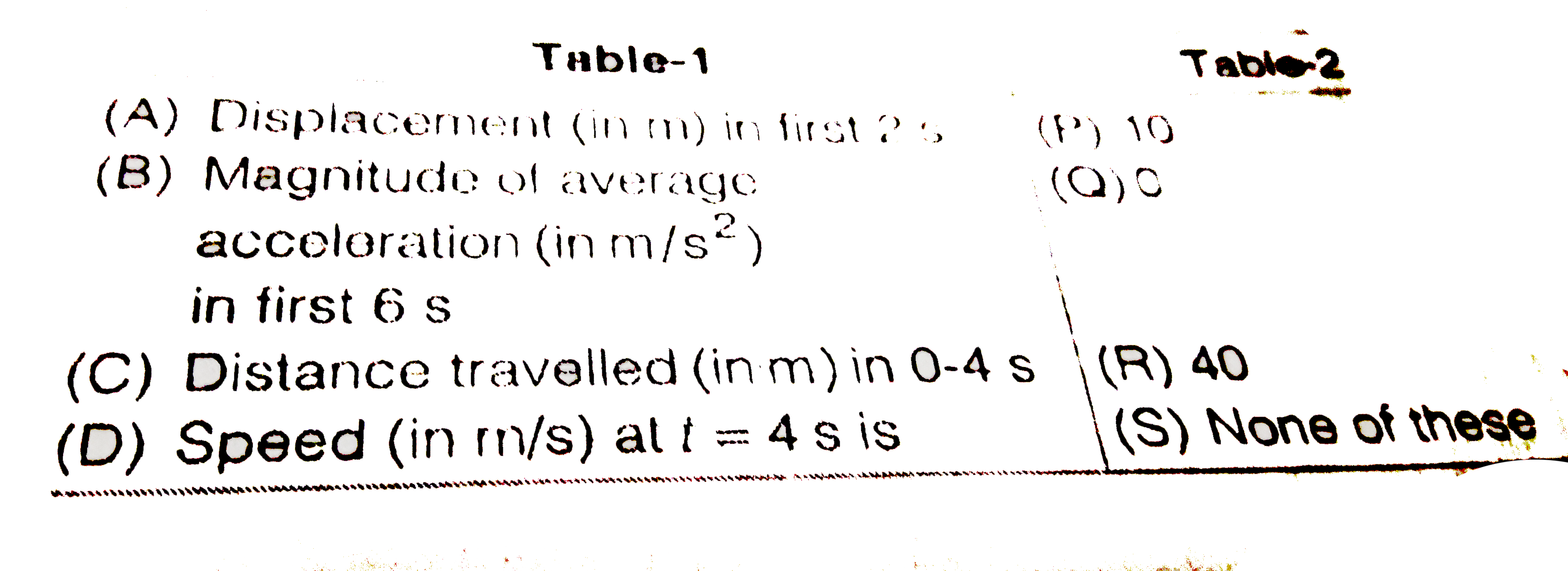A particle of mass 1 kg is thrown vertically upward with speed 100 m/s. After 5 sec it explodes into two parts. One part of mass 400 g comes back with speed 25 m/s, what is-the speed of the other part just after explosion? (g=10m/s2)
600 m/s upward
100 m/s upward
100 m/s down ward
300 m/s upward
The correct Answer is:B
To solve the problem, we will use the principles of kinematics and the conservation of momentum. Here’s a step-by-step breakdown of the solution:
Step 1: Calculate the velocity of the particle just before the explosion
The particle is thrown upwards with an initial speed u=100m/s. After t=5s, the velocity v of the particle can be calculated using the equation of motion:
v=u−gt
where g=10m/s2 (acceleration due to gravity).
Substituting the values:
v=100m/s−(10m/s2×5s)=100m/s−50m/s=50m/s
Step 2: Determine the masses of the two parts after the explosion
The total mass of the particle is 1kg. One part has a mass of 400g=0.4kg. Therefore, the mass of the second part is:
m2=1kg−0.4kg=0.6kg
Step 3: Analyze the motion after the explosion
After the explosion, one part (mass m1=0.4kg) comes back down with a speed of v1=−25m/s (negative because it is moving downwards). We need to find the speed of the second part (mass m2=0.6kg), which we will denote as v2.
Step 4: Apply the conservation of momentum
According to the law of conservation of momentum:
Initial momentum=Final momentum
The initial momentum before the explosion is:
pinitial=(1kg)×(50m/s)=50kg m/s
The final momentum after the explosion is:
pfinal=m1v1+m2v2
Substituting the known values:
50=(0.4)(−25)+(0.6)v2
Calculating (0.4)(−25):
50=−10+0.6v2
Rearranging the equation to solve for v2:
0.6v2=50+10=60
v2=600.6=100m/s
Step 5: Determine the direction of v2
Since the second part is moving upwards, we conclude that:
v2=100m/s (upward)
Final Answer
The speed of the other part just after the explosion is 100m/s upward.
---
The particle is thrown upwards with an initial speed u=100m/s. After t=5s, the velocity v of the particle can be calculated using the equation of motion:
v=u−gt
where g=10m/s2 (acceleration due to gravity).
v=100m/s−(10m/s2×5s)=100m/s−50m/s=50m/s
The total mass of the particle is 1kg. One part has a mass of 400g=0.4kg. Therefore, the mass of the second part is:
m2=1kg−0.4kg=0.6kg
After the explosion, one part (mass m1=0.4kg) comes back down with a speed of v1=−25m/s (negative because it is moving downwards). We need to find the speed of the second part (mass m2=0.6kg), which we will denote as v2.
According to the law of conservation of momentum:
Initial momentum=Final momentum
The initial momentum before the explosion is:
pinitial=(1kg)×(50m/s)=50kg m/s
The final momentum after the explosion is:
pfinal=m1v1+m2v2
Substituting the known values:
50=(0.4)(−25)+(0.6)v2
Calculating (0.4)(−25):
50=−10+0.6v2
Rearranging the equation to solve for v2:
0.6v2=50+10=60
v2=600.6=100m/s
Since the second part is moving upwards, we conclude that:
v2=100m/s (upward)
The speed of the other part just after the explosion is 100m/s upward.
Similar Questions
A particle of mass 1 kg is thrown vertically upwards with speed 100 m/s. After 5 s, it explodes into two parts. One part of mass 300 g comes back with speed 24 m/s, What is the speed of other part just after explosion?
(a) 100 m/s upwards (b) 600 m/s upwards
(c) 600 m/s upwards (d)81.7 m/s upwards
View SolutionA bomb of 1kg is thrown vertically up with speed 100m/s After 5 seconds it explodes into two parts. One part of mass 400gm goes down with speed 25m/s What will happen to the other part just after explosion .
View SolutionA mass of 1 kg is thrown up with a velocity of 100 m/s. After 5 seconds. It explodes into two parts. One parts of mass 400 g comes down with a velocity 25 m/s Calaculate the velocity of other parts:
View SolutionA mass of 1 kg is thrown up with a velocity of 100 m/s. After 5 seconds. It explodes into two parts. One parts of mass 400 g comes down with a velocity 25 m/s Calaculate the velocity of other parts:
View SolutionA particle of mass 100g is thrown vertically upwards with a speed of 5m/s. The work done by the force of gravity during the time the particle goes up is
View SolutionA particle of mass 20 g is thrown vertically upwards with a speed of 10 m/s. Find the work done by the force of gravity during the time the particle goes up.
View SolutionA ball is projected vertically up with speed 20 m/s. Take g=10m/s2
View SolutionA ball of mas 2gm is thrown vertically upwards with a speed of 30m/s from a tower of height 35m. (Given g=10m/s2)

View SolutionA projectile of mass 50kg is shot vertically upwards with an initial velocity of 100m/s. After 5s, it explodes into two fragments, one of which having a mass of 20kg travels vertically up with a velocity of 150m/s:
a. What is the velocity of the other fragment that instant?
b.Calculate the sum of rnornenta of fragment 3s after the explosion. What would have been the momentum of the projectile at this instant if there had been no explosion?
View SolutionA ball is thrown vertically upward with a speed of 20 m/s. Draw a graph showing the velocity of the ball as a function of time as it goes up and then comes back.
View Solution
